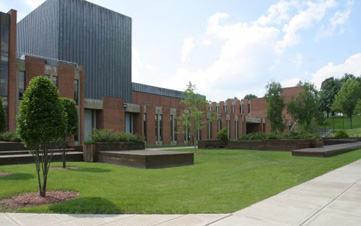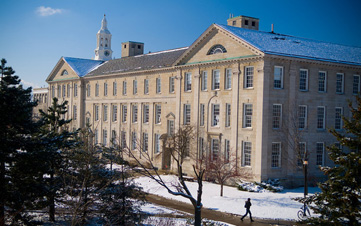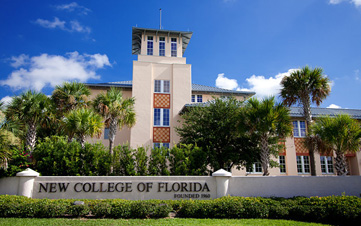10 Best Public Colleges With Lowest Debt at Graduation, 2014
As the cost of a college education continues to rise, the amount students borrow to cover those costs has crept up as well.


As the cost of a college education continues to rise, the amount students borrow to cover those costs has crept up as well. From 2008 to 2012, debt at graduation (including both federal and private loans) increased an average of 6% a year, according to the Project on Student Debt. More than 70% of the class of 2012 borrowed to help pay for their education, at an average of $29,400 per borrower.
The good news? These ten schools from our 2014 list of best values in public colleges offer academic quality as well as enough financial support to get students to graduation day with a manageable amount of student debt. At five of the schools on our list, students earn their diploma with an average debt of $17,000 or less. Take a look.

1. University of North Georgia
- Average debt at graduation: $12,166
- Kiplinger's ranking: #94
- Undergrad enrollment: 5,851
- Annual in-state cost: $14,554
- Students who borrow: 57%
The University of North Georgia has some of the lowest sticker prices (for both in-state and out-of-state students) on our list. The below-average cost of attendance, paired with generous financial aid (including the HOPE scholarship, available to in-state students who qualify based on academics) reduces the need for students to borrow. Also, students here graduate with an average debt that's about 60% less than the national average -- and the lowest amount on our list.
The school was formed in January 2013, when North Georgia College & State University (which appeared on our list three times over the past four years) and Gainesville State College merged. Now, with four campuses north of Atlanta, the school has more than 50 bachelor’s degree programs in five colleges.

2. SUNY Oneonta
- Average debt at graduation: $15,373
- Kiplinger's ranking: #74
- Undergrad enrollment: 5,863
- Annual in-state cost: $19,486
- Students who borrow: 66%
Located halfway between Albany and Binghamton, New York, SUNY Oneonta’s 250-acre campus overlooks the idyllic Susquehanna River Valley and the small city of Oneonta. While two-thirds of students take out loans, the average amount that each student borrows is about half the national average. Each year, the school awards more than $2 million in scholarships based on academic achievement, including awards to about 30% of the freshman class. The average need-based aid award, $4,709, reduces the in-state tuition to $14,777.

3. SUNY Buffalo
- Average debt at graduation: $16,025
- Kiplinger's ranking: #51
- Undergrad enrollment: 19,505
- Annual in-state cost: $21,447
- Students who borrow: 45%
As the largest residential school in SUNY’s 64-campus system, the University at Buffalo offers more than 100 undergraduate degree programs. The average need-based aid award of $5,140 reduces the cost to $16,307 for in-state students. The school's “Finish in 4” program focuses on helping students graduate on time and avoid the expense of an additional year. Incoming freshmen work with an adviser to craft a four-year plan and pledge to fulfill a list of obligations -- including limiting work to less than 20 hours per week and completing tasks such as course registration and financial aid forms on time. If a student meets these commitments but still doesn’t graduate in four years, UB will waive tuition and fees for any remaining coursework.

4. University of North Carolina at Chapel Hill
- Average debt at graduation: $16,983
- Kiplinger's ranking: #1
- Undergrad enrollment: 18,503
- Annual in-state cost: $19,676
- Students who borrow: 35%
- The school meets 100% of a student’s demonstrated financial need, the only one on our list to do so. The average need-based aid award of $13,222 reduces in-state cost to an average of $6,454. UNC also ranks as the best value for out-of-state students, with an average cost of $28,336 after need-based aid. Compared with last year, a smaller percentage of UNC students are taking out loans -- and among those who do, the average debt has gone down by almost $500.
UNC has topped our best-values list 13 consecutive times. Stellar academics, including a 28% admission rate (the third-most competitive on our list), a high freshman retention rate (97%) and the third-highest four-year graduation rate on our list (77% of students graduate in four years) contribute to UNC’s top ranking, as does its generous financial aid, which keeps student borrowing to a minimum.

5. University of North Florida
- Average debt at graduation: $17,000
- Kiplinger's ranking: #64
- Undergrad enrollment: 14,398
- Annual in-state cost: $16,718
- Students who borrow: 42%
About 20 miles east of downtown Jacksonville, Fla., the University of North Florida, which opened in 1972, meets 90% of a student’s demonstrated financial need -- one of the highest percentages on our list. Need-based aid averaging $5,370 and an expansive list of merit and need-based scholarships, from $1,000 one-time awards to four-year full rides, help keep student indebtedness well below the national average.

6. University of Texas at Dallas
- Average debt at graduation: $17,516
- Kiplinger's ranking: #39
- Undergrad enrollment: 12,029
- Annual in-state cost: $22,246
- Students who borrow: 36%
As colleges continue to look for ways to ease the pressure of rising tuition, the University of Texas at Dallas has already made a promise to its students. The school, which is located just north of downtown Dallas, offers students the Guaranteed Tuition Plan, which locks in tuition and required fees for four years. In-state students can take courses beyond the usual 15 credit hours at no additional cost.
Enrollment and graduation rates are both on the rise at UT Dallas. Just over half of applicants are accepted – and about 40% of accepted students ultimately enroll. The school offers 133 academic programs and more than 200 clubs and student organizations.

7. San Diego State University
- Average debt at graduation: $17,600
- Kiplinger's ranking: #76
- Undergrad enrollment: 26,624
- Annual in-state cost: $22,324
- Students who borrow: 44%
Located two hours south of Los Angeles and just a short drive from downtown San Diego, the Pacific Ocean and the mountains, San Diego State University is one of the largest universities in the state. SDSU helps keep student borrowing to a minimum with scholarships, including many awards for specific areas of study, and an average financial aid award of $10,100. Beginning in the 2014-15 academic year, California residents with family income up to $150,000 may quality for the Middle Class Scholarship. This currently modest award will increase as the program is phased in over the next four years.

8. University of North Carolina at Asheville
- Average debt at graduation: $17,696
- Kiplinger's ranking: #58
- Undergrad enrollment: 3,693
- Annual in-state cost: $15,047
- Students who borrow: 58%
UNC Asheville’s 265-acre campus, located about a mile from downtown Asheville, is nestled in the Blue Ridge Mountains. The school’s in-state sticker price is one of the lowest on our top 100 list, and more than 60% of students receive financial aid. The average need-based aid award, $6,096, reduces in-state costs to $8,951. The school also keeps student borrowing to a minimum with a variety of merit scholarships and grants, including the Laurels scholarships, offered to freshmen with strong academic records. These awards top out at the full cost of attendance, and most are renewable as long as the student continues to meet the requirements.

9. University of California, Berkeley
- Average debt at graduation: $17,964
- Kiplinger's ranking: #9
- Undergrad enrollment: 25,774
- Annual in-state cost: $29,280
- Students who borrow: 40%
Although it has the third-highest sticker price on our top 100 list, the University of California’s flagship campus gets students to the finish line with about one-third less debt than the national average, thanks to a strong four-year grad rate (71%) and generous financial aid. UC Berkeley’s Blue and Gold Opportunity Plan helps cover tuition and fees for in-state students with financial need and annual family income below $80,000.
In addition to the Middle Class Scholarship Program, an income-based program offered by the state, the school also has the Middle Class Access Plan. That program caps parent contributions at 15% of income for students of families who earn between $80,000 and $140,000. All told, about two-thirds of UC Berkeley students receive some form of financial aid. The average need-based aid award-- $16,629-- reduces in-state tuition to $12,651.

10. New College of Florida
- Average debt at graduation: $18,276
- Kiplinger's ranking: #11
- Undergrad enrollment: 832
- Annual in-state cost: $16,867
- Students who borrow: 39%
Located in Sarasota, along the Gulf of Mexico, New College’s 110-acre main campus sits on the former estate of circus owner Charles Ringling. It originated as a private institution but joined the state university system in 1975. The school offers financial aid to 90% of students -- and the average need-based aid award of $8,819 drops the average cost of attendance for in-state students to $8,048. Less than 40% of undergraduates take out loans -- among the lowest percentage of student borrowers on our top 100 list.

Get Kiplinger Today newsletter — free
Profit and prosper with the best of Kiplinger's advice on investing, taxes, retirement, personal finance and much more. Delivered daily. Enter your email in the box and click Sign Me Up.

-
 Free IRS Tax Filing for 30 Million People: Will It Continue Under Trump?
Free IRS Tax Filing for 30 Million People: Will It Continue Under Trump?Tax Filing Direct File was piloted last year in 12 states and has since expanded to 25. But some wonder whether the program will last under the Trump administration.
By Gabriella Cruz-Martínez Published
-
 Financial Security vs Financial Freedom: What's the Difference?
Financial Security vs Financial Freedom: What's the Difference?Having the ability to pivot without worrying about financial support is where financial security becomes financial freedom.
By Justin Donald Published
-
 What to Do With Your Tax Refund: 6 Ways to Bring Growth
What to Do With Your Tax Refund: 6 Ways to Bring GrowthUse your 2024 tax refund to boost short-term or long-term financial goals by putting it in one of these six places.
By Rachael Green Published
-
 What Does Medicare Not Cover? Eight Things You Should Know
What Does Medicare Not Cover? Eight Things You Should KnowHealthy Living on a Budget Medicare Part A and Part B leave gaps in your healthcare coverage. But Medicare Advantage has problems, too.
By Donna LeValley Published
-
 15 Reasons You'll Regret an RV in Retirement
15 Reasons You'll Regret an RV in RetirementMaking Your Money Last Here's why you might regret an RV in retirement. RV-savvy retirees talk about the downsides of spending retirement in a motorhome, travel trailer, fifth wheel or other recreational vehicle.
By Bob Niedt Published
-
 The Six Best Places to Retire in New England
The Six Best Places to Retire in New Englandplaces to live Thinking about a move to New England for retirement? Here are the best places to land for quality of life, affordability and other criteria.
By Stacy Rapacon Last updated
-
 The 10 Cheapest Countries to Visit
The 10 Cheapest Countries to VisitWe find the 10 cheapest countries to visit around the world. Forget inflation woes, and set your sights on your next vacation.
By Quincy Williamson Last updated
-
 15 Ways to Prepare Your Home for Winter
15 Ways to Prepare Your Home for Winterhome There are many ways to prepare your home for winter, which will help keep you safe and warm and save on housing and utility costs.
By Donna LeValley Last updated
-
 Six Steps to Get Lower Car Insurance Rates
Six Steps to Get Lower Car Insurance Ratesinsurance Shopping around for auto insurance may not be your idea of fun, but comparing prices for a new policy every few years — or even more often — can pay off big.
By Donna LeValley Published
-
 How to Increase Credit Scores — Fast
How to Increase Credit Scores — FastHow to increase credit scores quickly, starting with paying down your credit card debt.
By Lisa Gerstner Last updated
